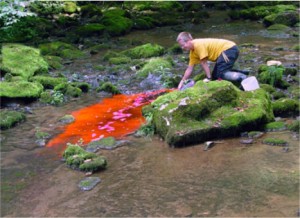This website uses a variety of cookies, which you consent to if you continue to use this site. You can read our Privacy Policy for
details about how these cookies are used, and to grant or withdraw your consent for certain types of cookies.
An Overview of Tracer Dilution for Flow Rate Determination in Natural Streams
 Tracer dilution is a method of determining the flow rate in a ground or surface water environment where a hydraulic structure (flume / weir) cannot be installed either due to cost, monitoring duration, or ecological reasons. The technique has been in use for over a century is a valuable tool for a variety of hydrological and hydrogeological investigations.
Tracer dilution is a method of determining the flow rate in a ground or surface water environment where a hydraulic structure (flume / weir) cannot be installed either due to cost, monitoring duration, or ecological reasons. The technique has been in use for over a century is a valuable tool for a variety of hydrological and hydrogeological investigations.
There are two general types of tracer investigations used: natural and artificial. In natural dilution substances already in the water are analyzed. While in artificial trace studies, a substance, dye, or chemical is injected into the water and its time concentrated development is used to determine the flow rate.
For irrigation studies, salts and dyes are the most commonly and convenient used tracers.
If a dye is used, a color based on contrast with the background of the water body should be used (i.e. red dyes for use in algae laden waters). Fluorescent colors are frequently used as they can be visually detected in most water conditions or by a UV light / fluorometer. For waters with heavy sediment loads, yellow/green fluorescent dyes are commonly used as (depending upon the formulation) they are resistant to the absorption of organic matter.
In selecting a dye, it is important to make sure that the dye is bio-degradable or otherwise approved for the application.
Historically one drawback to tracer dilution was the need for laboratory analysis of the water samples. More modern devices like Flow-Tronic’s Flow-Tracer can allow for real-time data collection.
Image: Chromatech
Sources: Chromatech, Flow-Tronic, Wolkerdofer, Water Measurement Manual (Chapter 12)
Related Blog Posts
Explore more insights in our blog.

LOCATIONS IN ATLANTA, GA & BOISE, ID




